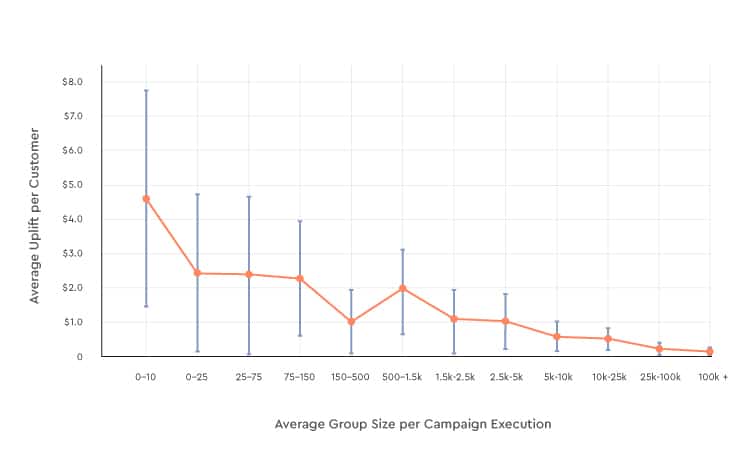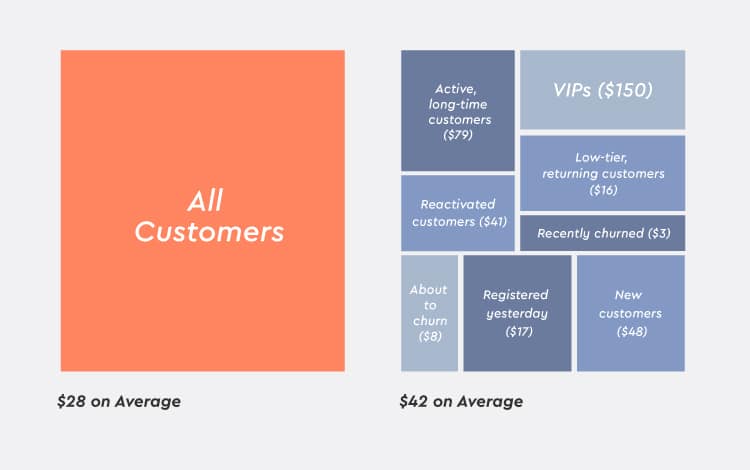
AI and the Retail Marketer’s Future
How AI transforms strategy and processes, driving the adoption of Positionless Marketing
Exclusive Forrester Report on AI in Marketing

In a recent CommerceNext survey of CMOs, "Retention/Loyalty Marketing" was named the area where marketing leaders are looking to increase their investment the most. Within it, "scaling segmentation" - an essential requirement for a proper retention/loyalty strategy - came in second as the biggest challenge in retention marketing.
(and this is where we say that, actually, scaling segmentation isn't such a headache, if you got the right technology, ahem ahem)
Nowadays, marketing leaders are so aware of the power of smart CRM Marketing, the importance of personalization at scale, and the impact of micro-segmentation - that even when asked about their priorities for the holiday/shopping season of late 2021, "Retention/Loyalty Marketing" came in 3rd, only behind "acquisition" (#1) and "eCommerce/site experience" (at #2).
At the heart of it all lies the assumption that the more granular the customer group, the more the offer can be tailored to specific customers' needs and wants, leading to higher engagement and increased revenue.
So we ran comprehensive research, took a deep dive into the numbers, and resurfaced with a clear conclusion that all these marketing folks? They're on to something!
So, would presenting a different offer to small groups of consumers with similar attributes generate more uplift than sending the same offer to all consumers? In simpler terms - is there a connection between personalization at scale and impact on revenue?
Spoiler alert: Yup, there is.
More from Optimove on segmentation:RFM Segmentation
Paul Stuart Revolutionizes Its Customer Marketing with Optimove
Customer Segmentation via Cluster Analysis
Our data set consisted of over 30 million customers and 2,000 campaigns, delivered to target groups ranging in size from one customer per group to groups of over 100,000 customers. For each target group size, we measured the average campaign uplift. We plotted the results – average uplift per customer and the extent of each group's results volatility – on a graph:

Looking at the results, it is clear that when conducting customer marketing campaigns, segmentation does indeed stand up to its promise. The smaller the target group, the larger the uplift. For the smallest size group, the average uplift is $4.70 per customer, whereas when extremely large groups of customers are targeted – 100,000 or more – the average monetary uplift is merely $0.10. With the decrease in average uplift as group sizes grow bigger, it could also be observed that small target groups—say, up to 150 customers per campaign—clearly dominate all large target groups. For example, all target groups with up to 150 customers had at least a $1.90 uplift per customer, while target groups of 1,500+ had an uplift of at most $0.50 (almost a 4:1 ratio).
Small groups tend to have higher volatility, meaning that because the sample sizes are smaller, the variation in results tend to be greater. The results of our study showed that the smaller the group is, the larger the range of possible campaign outcomes. This is an expected result, as small groups tend to suffer from high variance regardless of the subject being tested. The implication is that even though marketers can expect better results from smaller, more targeted segments, there are exceptions to this rule. With smaller groups, the best results are achieved the more homogeneous and coherent a target group is, and the better the offer is suited to that group.
The overall message is clear: as you cater to smaller and smaller segments, the average uplift you can expect to gain from your total customer base grows. In smaller groups, each customer will generate more uplift on average than if he or she were approached as a part of a larger group. When a group of customers is segmented and targeted by many small campaigns, the accumulated uplift is much higher in comparison to the results of a "spray and pray" campaign. This is clear if we envision targeting all customers, as opposed to granular, coherent customer segments:

The results of this comprehensive study of target group granularity resonates with our real-world experience: the better we know a customer, the more personal the value proposition we can offer him or her, and the higher the chance that this offer will hit home and result in the desired brand engagement.
In his 2004 famous Ted Talk, Choice, Happiness and Spaghetti Sauce, Malcolm Gladwell talked about cluster analysis in marketing and helped to popularize the notion that marketing SHOULD be personalized. He wrapped up his talk with an example from the world of coffee, saying how, when people are asked which coffee they like, he says, the universal answer is “a dark, rich, hearty roast.” But if you were to serve them exactly that kind of brew, it will receive a general score of 60 on a scale from 0 to 100.
However, if you broke the population down into coffee clusters according to their coffee preferences, and make coffee for each of those individual clusters, the score would go up from 60 to 78. According to Gladwell, “The difference between coffee at 60 and coffee at 78 is the difference between coffee that makes you wince and coffee that makes you deliriously happy.”
Granularity has the potential to make customers deliriously happy. And as our study shows, embracing the diversity of human beings by speaking to each according to their tastes – even when they are unarticulated – is a surefire way to speak to their hearts, and to affect your bottom line.
Exclusive Forrester Report on AI in Marketing
In this proprietary Forrester report, learn how global marketers use AI and Positionless Marketing to streamline workflows and increase relevance.


Writers in the Optimove Team include marketing, R&D, product, data science, customer success, and technology experts who were instrumental in the creation of Positionless Marketing, a movement enabling marketers to do anything, and be everything.
Optimove’s leaders’ diverse expertise and real-world experience provide expert commentary and insight into proven and leading-edge marketing practices and trends.


